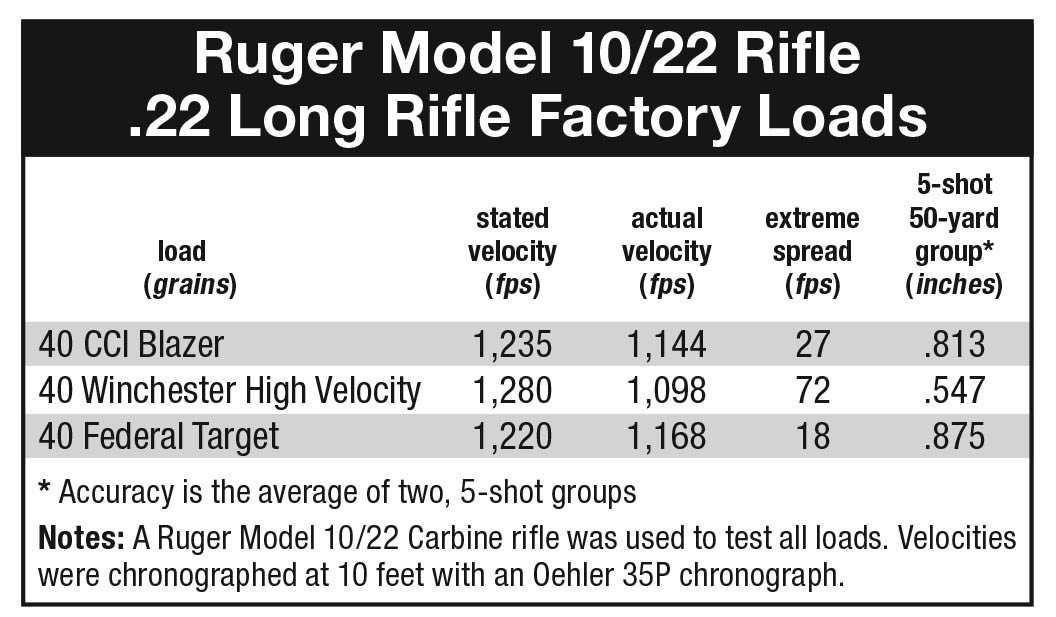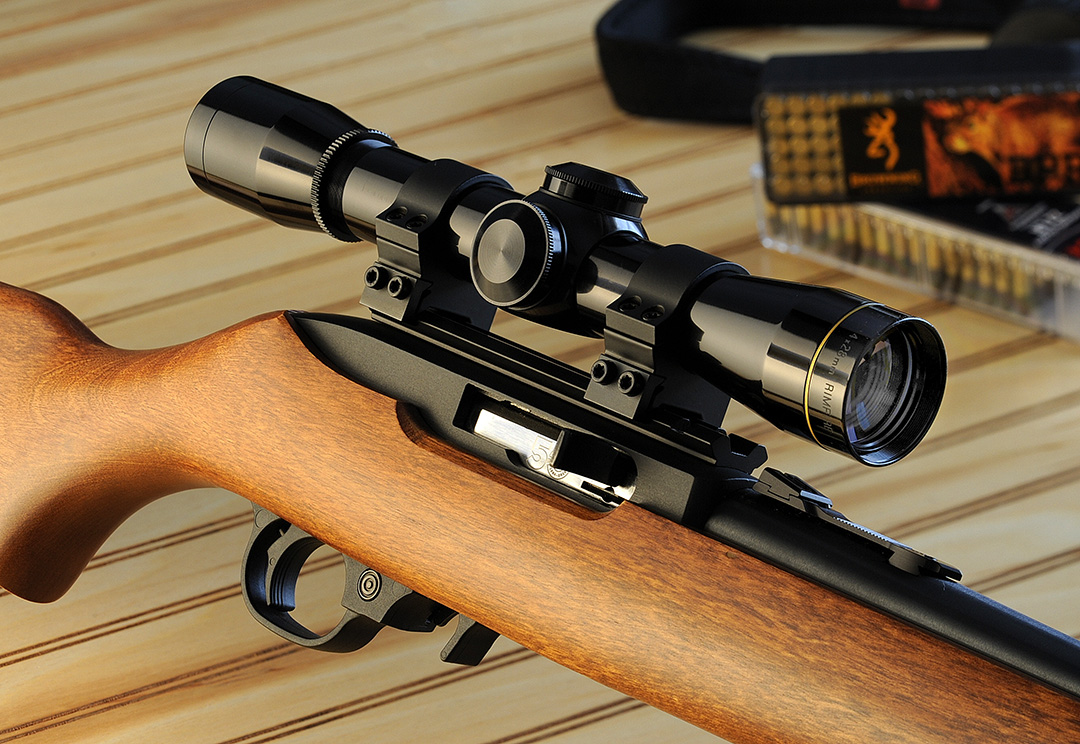
This is the Ruger Model 10/22 Carbine topped off with a Leupold 4-28mm Rimfire scope. A shooter could not ask for a better combination for hunting, target shooting or plinking.
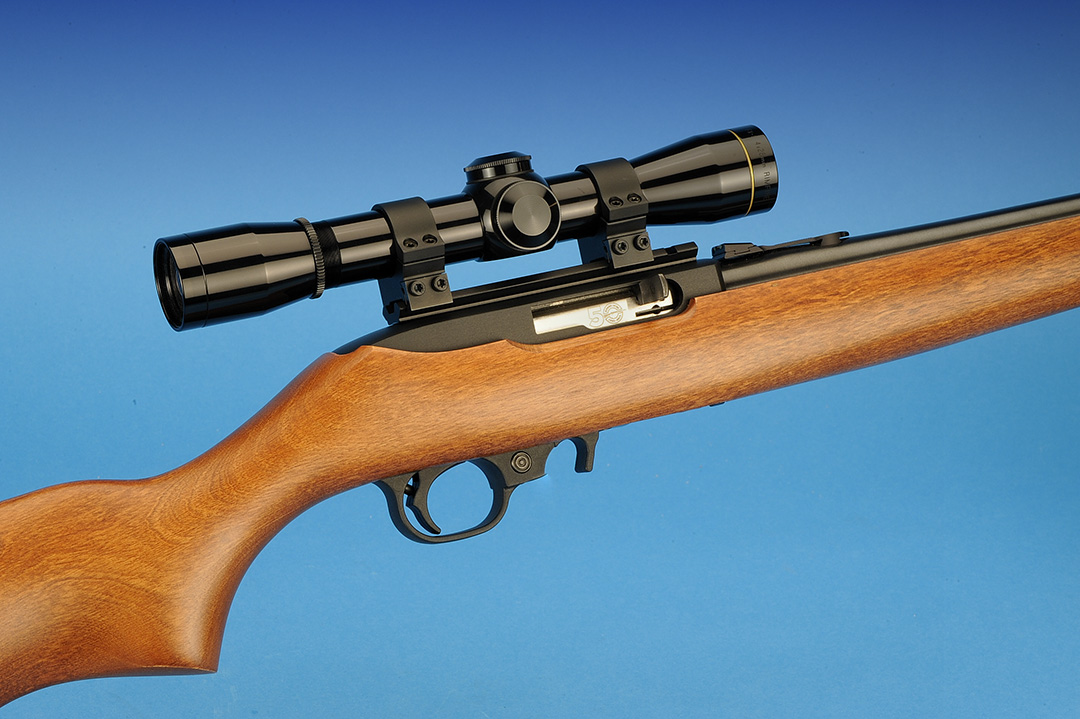
Slim lines with top-notch design make this Ruger a best bet for any outdoor activity. Using economical .22 Long Rifle ammunition for the money and accuracy is great at 50 yards.
Sitting in the rack at the store, the Ruger 10/22 rimfire rifle was not my first choice that day. Counting my money and scanning the rifles behind the impatient clerk, the Marlin Model 39 levergun seemed to call my name. Since I did have the Ruger Single Six complete with the magnum cylinder, the Marlin seemed to be the logical choice. Reading up on stories of having two guns chambered for the same cartridge certainly did appeal to this young hunter, so the Marlin complete with a Weaver scope went home with me for the summer woodchuck season on the farm.
Although it took quite a few years to finally get my hands on a fabled Ruger 10/22, I did manage to pick a special edition brought out by Williams Shooters Supply as a 50
th Anniversary Carbine model. Now discontinued, this Ruger came with a hardwood stock, sans checkering, a plastic buttplate and a permanent place on my gun rack. As chambered for the very popular .22 Long Rifle cartridge, the roots of this ammunition go back to 1831. This is a date established as the starting point of the BB cap (bulleted breech cap). Louis Flobert, who lived from 1819 to 1894, is credited with inventing the first rimfire metallic cartridge in 1845 and it was used primarily as “parlor rifles” at parties to add a little excitement to invited guests in the front room. Today, .22 rimfire ammunition is made in such great quantities, that if I had just one penny for each round made, I’d be on an island some place in the Pacific enjoying life.
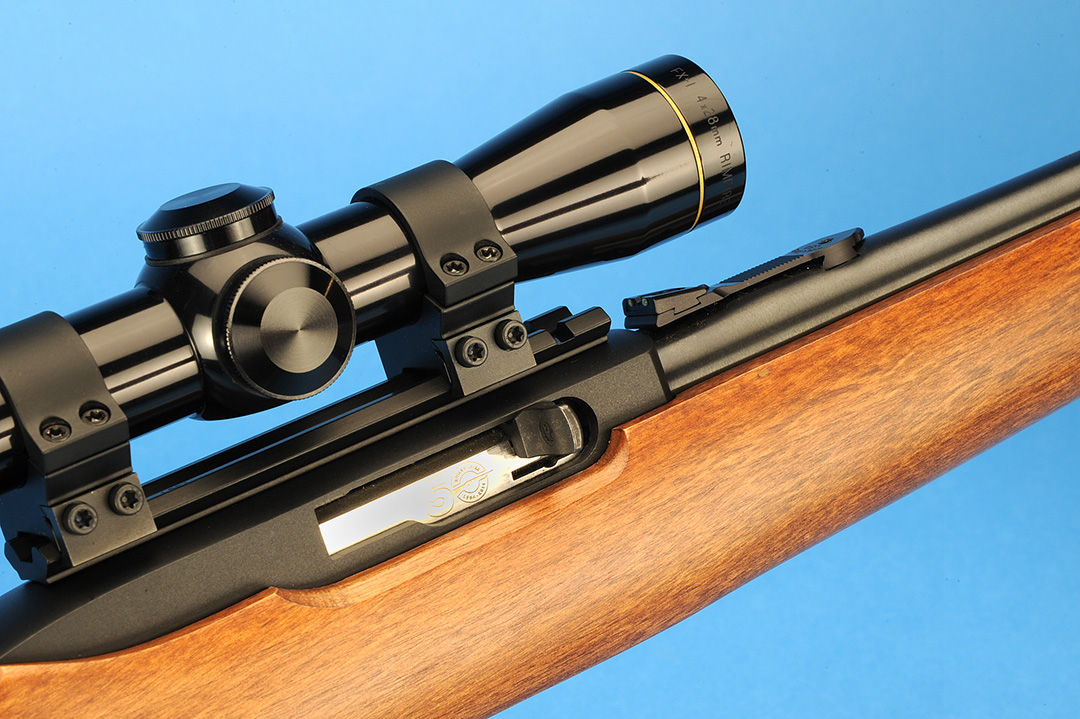
Closer in, we get to see the details on this special edition, including roll engraving on the bolt and a different set of rear sights. The finish on the stock and bluing is first-class.
Looking back, and like all Ruger products, has nothing short of an interesting background. In 1964, with Bill Ruger at the helm, the new gun had accolades that read “designed with sound engineering, smooth handsome finishes, racy lines and perfect balance,” all pointed to a gun that would appeal to the masses regardless of age. At an introductory price of around $54.50, Ruger’s plan was simple and to the point, to the tune of almost three million guns sold in less than three decades would prove he was right – again!
As the beat rolled on, so did the models and variations. Looking at reference material in “Ruger & His Guns,” by R.L. Wilson, models came out as the Standard Carbine, International, International Sporter with a full-length Mannlicher and various special editions to include birch, checkered American walnut, or stocks profiled in laminated wood with more than enough colors and laminations to suit any hunter or sportsman. With all this going for it, gun distributers and even Walmart raced to the scene with orders in the thousands, filling any void left untouched by those in the business, in both blued and stainless. Additionally, commemorative guns like those dedicated to the Canadian Centennial, the FBI (Faber Brothers, Inc., not the Federal Bureau of Investigation) with a special-colored stock, the Kittery Trading Post with a porcelain medallion inlaid into the stock or the military version complete with a silencer (or suppressor) were often seen in the production line.
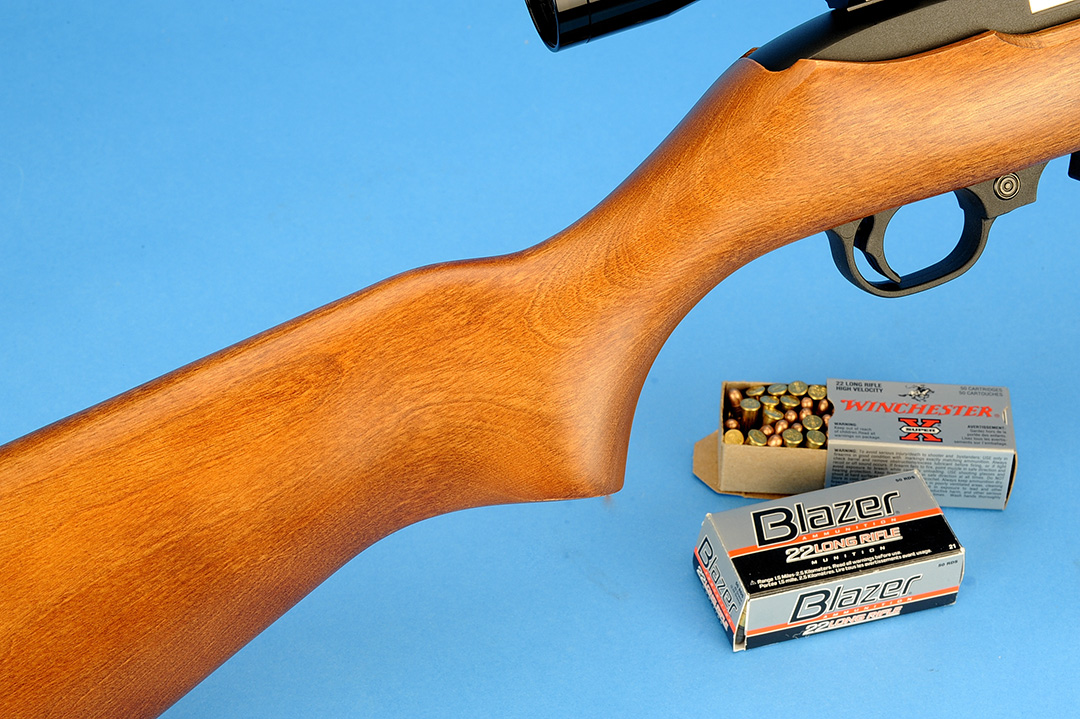
Stan’s stock was a plain version without checkering, nevertheless, it was comfortable to hold and shoot. Other models are available with modest upgrades if so desired.
That was yesterday, and today, the Model 10/22 is certainly not your father’s Oldsmobile. While the basic design and engineering has changed little, the long list of models now available currently rests at 16 with hardwood, synthetic, American walnut and laminates the choices in stock furniture. Carbon blue or stainless is still on tap for the barreled actions and aside from the traditional guns shooters presently have a choice of the Carbine, Takedown, Silent-SR ISB or the shortened Charger models in 21 variations. Intermixed into all this are guns classified as Target, Compact, Tactical, Sporter as well as newer competition guns from the Ruger Custom Shop that hit the high side of $800-plus.
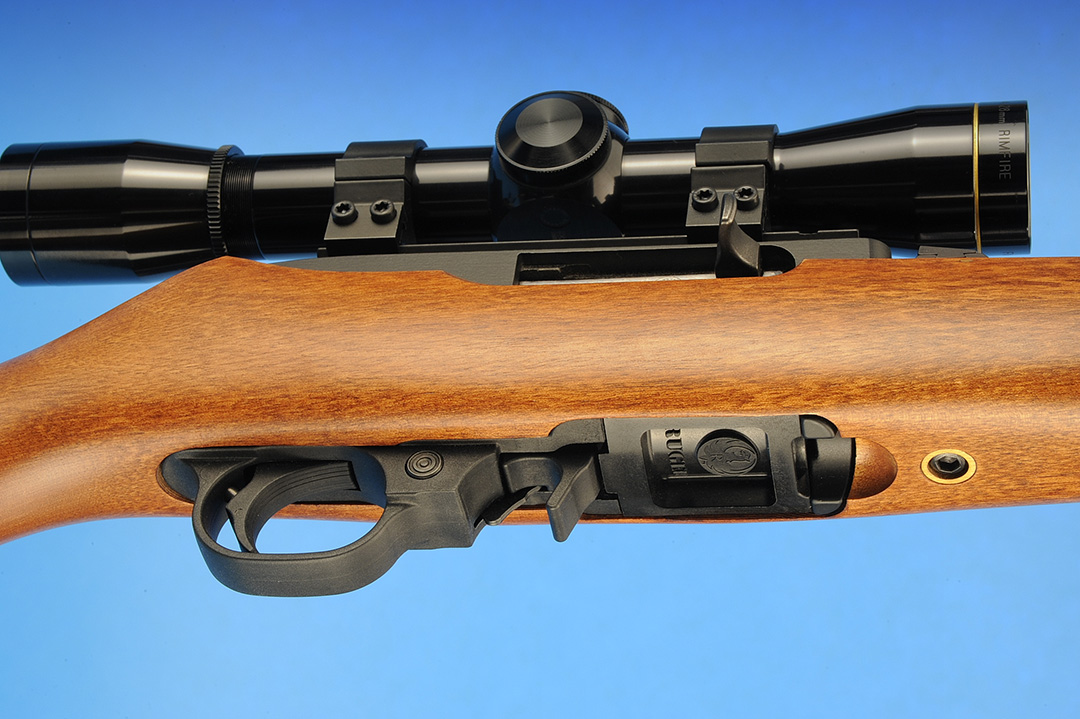
Looking under the gun, from left to right: the trigger and guard, cross-button safety, magazine release, magazine and the one stock screw holding the action to the stock in place.
Considering how many Ruger 10/22’s are made each year, the quality of the guns still stands tall. On my sample, with the plain hardwood stock, the finish is smooth to the touch; the inletting looks like the hands of surgeon had a part in it and the buttplate mates to the buttstock perfectly. Bill Ruger was never known for his taste in the so-called “California” high-combed stocks and his classic touch in rifles follows through in the Model 10/22.
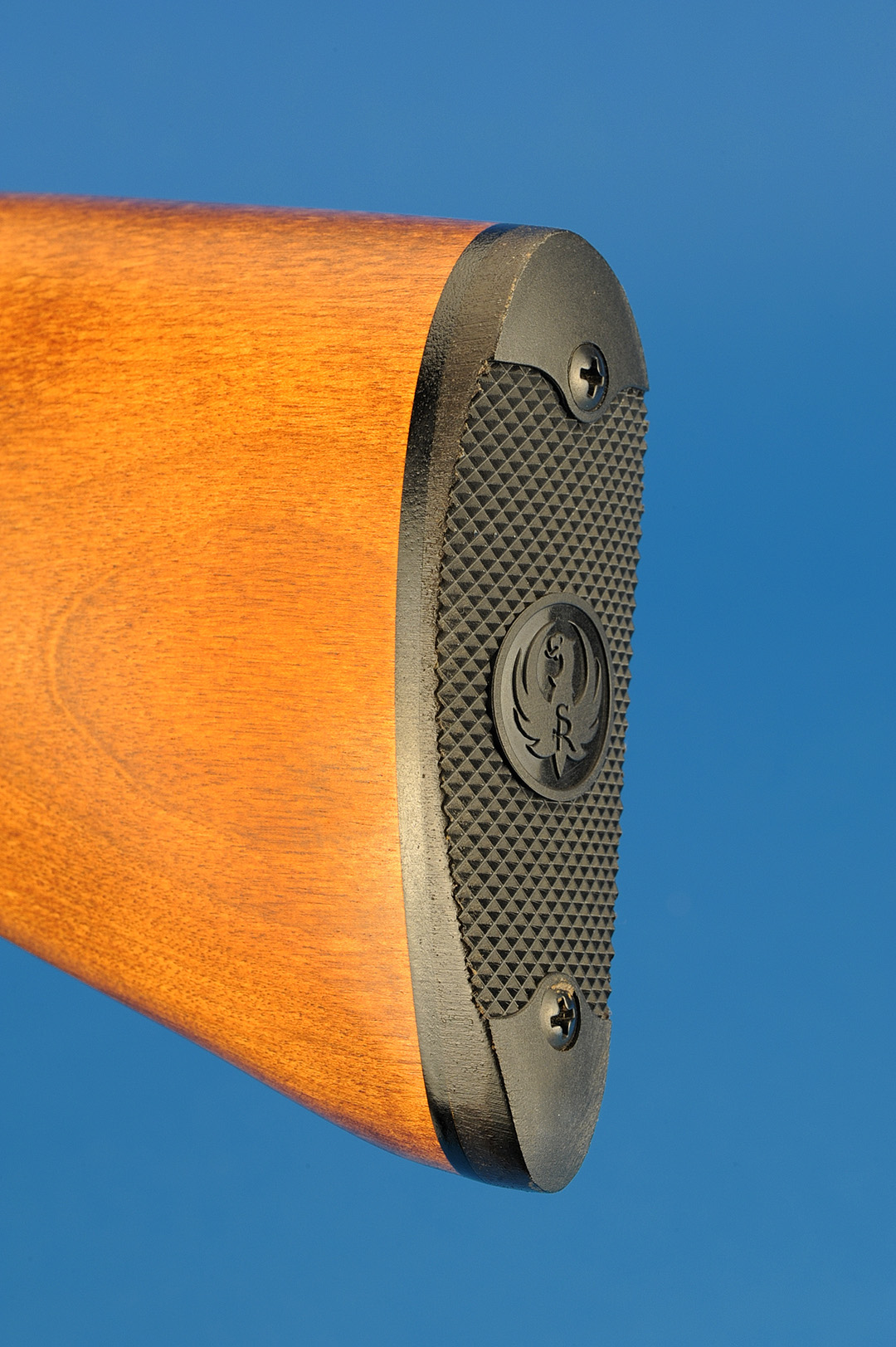
The model of the gun dictates how the stock will be finished. On this gun, there is a heavily-checkered plastic buttplate fitted to the stock with precision. Other guns might have a rubber pad, curved plastic or one that is fully adjustable.
Picking up the rifle shows the design team has a lot going for it. Starting at the forearm, the stock is slimmed down at the tip, gradually widens as it approaches the receiver, magazine and trigger assembly. From there, it’s reduced down a bit again at the full pistol grip and to the rear of the buttstock. Here, the stock is capped off with a well-checkered plastic buttplate that on some models is rubber, which I prefer in the field. On this carbine model there is no checkering. If that is a preference, jump over to the Sporter or one of the synthetic models. No sling swivels were installed on this model. However, newer Sporter guns have the studs installed, and for protection of the pistol grip in the field. Regrettably, there is no cap.
The overall design of the 10/22 closely follows the lines of the .44 Magnum Carbine that was discontinued around 1985, but that is as far as it goes. On the .22 version, the action is of the blowback-operated type that is workable on the .22 rimfire simply because of the low power of the host cartridge and is put in motion by pulling the trigger and setting off a round. To keep the gun from going into a fully-automatic mode, a disconnector is employed to prevent the gun from being fired for more than one shot with each pull of the trigger. Trigger pull on this mass produced gun hit the high side of 4 pounds, but on the other hand, it did break with a minimal amount of take-up before the sear broke.
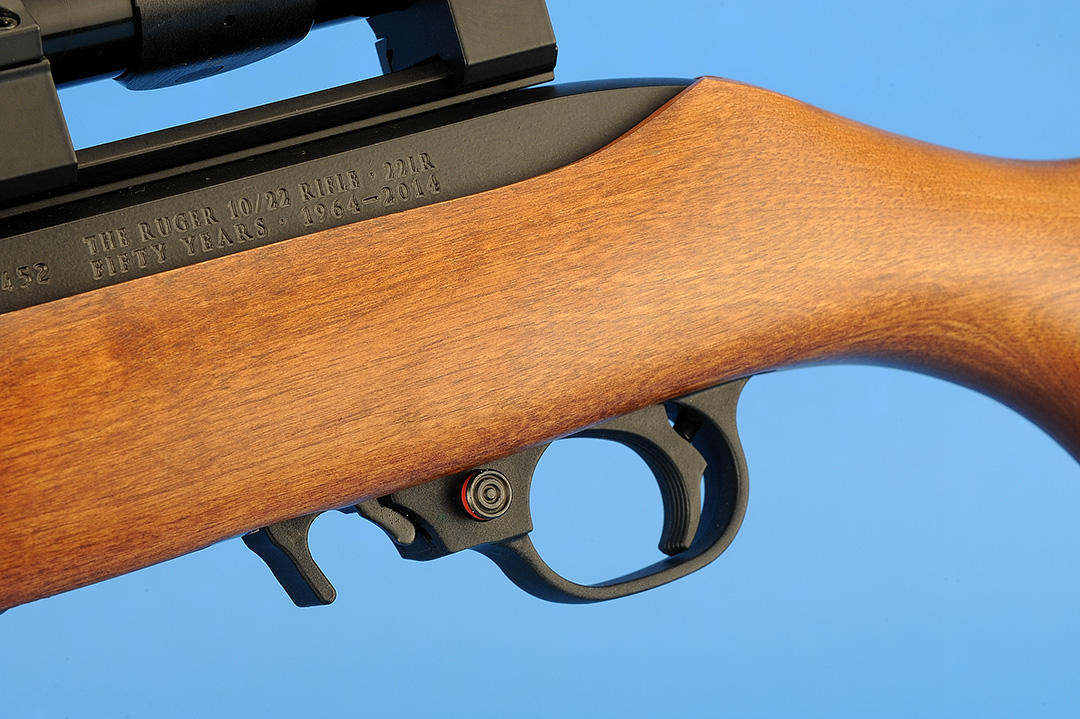
On the left side of the gun is the magazine release and the cross-bolt safety. Just in front of the safety is the bolt lock/release and the attention given to the finishing of the hardwood stock.
Ruger firearms are noted for innovative design features and the Model 10/22 is no exception. While sights vary from model to model, with some guns having a scope base included in the price, on my gun, the rear sight is adjustable while the front sight is equipped with fiber-optics. The steel cold hammered 20-inch barrel is attached to the receiver via a clever twin screw V-block arrangement that in practice draws the barrel tightly up against the receiver face eliminating the operation of threading the barrel into the receiver. While this arrangement might lead to tinkering by some home gunsmiths for whatever reason, if a rifleman wanted to install an aftermarket barrel, let qualified personal do it. By the way, another Ruger first is that the action is held into the stock by only one screw located forward of the box magazine.
When it comes to materials, the so-called “bottom metal” and the receiver are made from a lightweight aluminum alloy casting with the steel bolt completed in a hard chrome finish. The top of the receiver is drilled and tapped for commercial scope bases or rails and to this, I mounted a Leupold 4-28mm Rimfire scope in medium rings.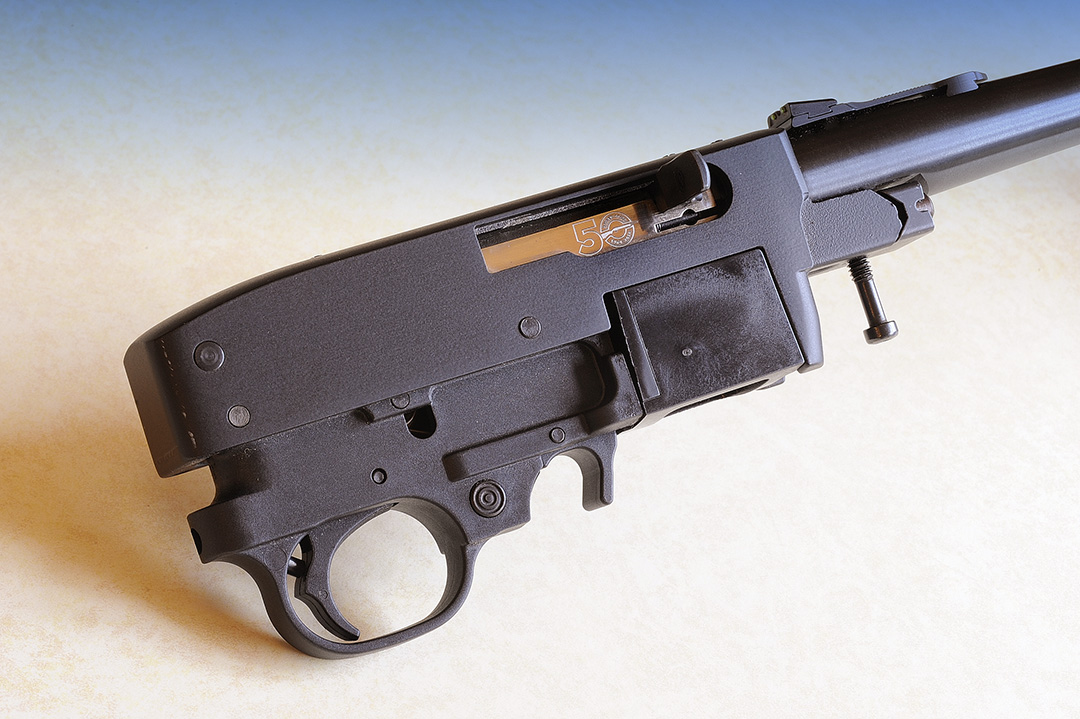
Out of the stock, the action is pure simplicity as engineered by the Ruger design team even back to 1964 and still it stands today. Note the single stock screw up front combined with the V-Block arrangement securing the barrel to the receiver.
Since the gun was designed and built from the ground up, I am sure the engineering team thought hard and long on how rounds would be fed into the chamber. The end result was a neat little magazine that held 10 rounds in a rotating arrangement that has proven to be flawless in functioning. The housing is plastic with the 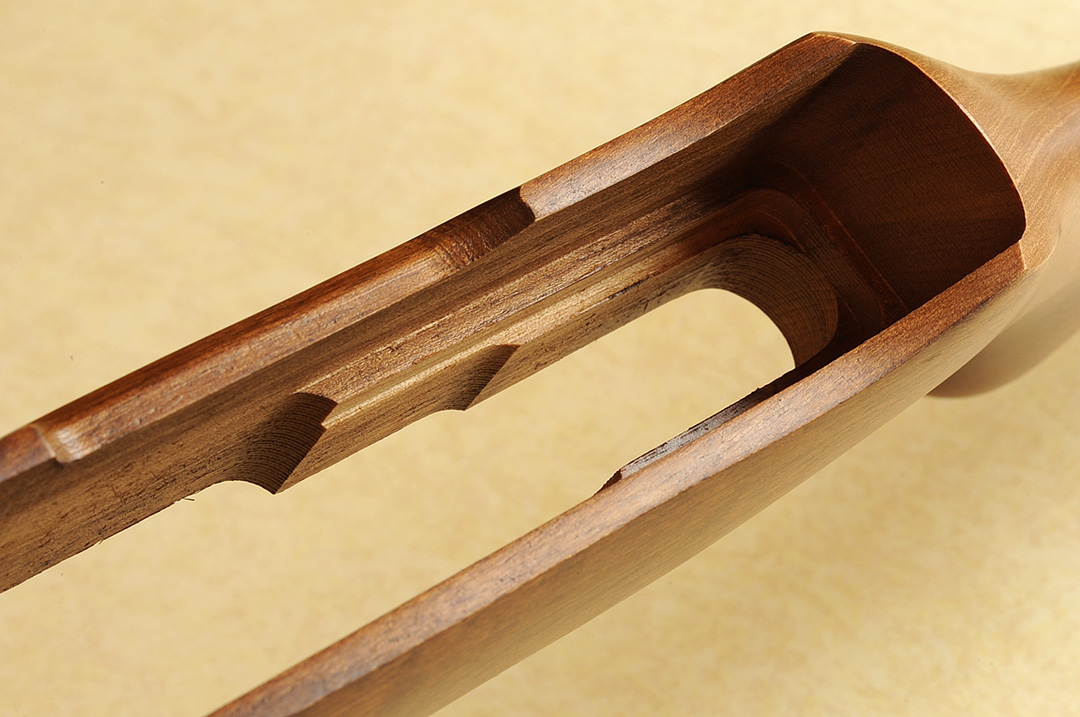
It is interesting to note how precise the inletting is on this gun despite its low price tag. In addition, this is how the gun came from the box with no debris inside.
Safety is always paramount with Ruger and when it came to the bolt lock, it was applied here and while it takes a few times for the new owner to operate it, the design has its merits. Since the bolt does not lock after the last round has been fired, it is up to the shooter to lock it back manually when loading. This is accomplished by the bolt lock located forward of the trigger guard and behind the magazine release. This is a rocking-type of affair, and to lock the bolt back, press the back part of the lock. To release the bolt, hold it back slightly to release the pressure and push down on the front part of this lever.
A cross button safety is located at the forward curve of the trigger guard and easy to operate. Pushing the button to the left allows the gun to fire (red ring showing) while pushing it to the right, places the gun on safe.
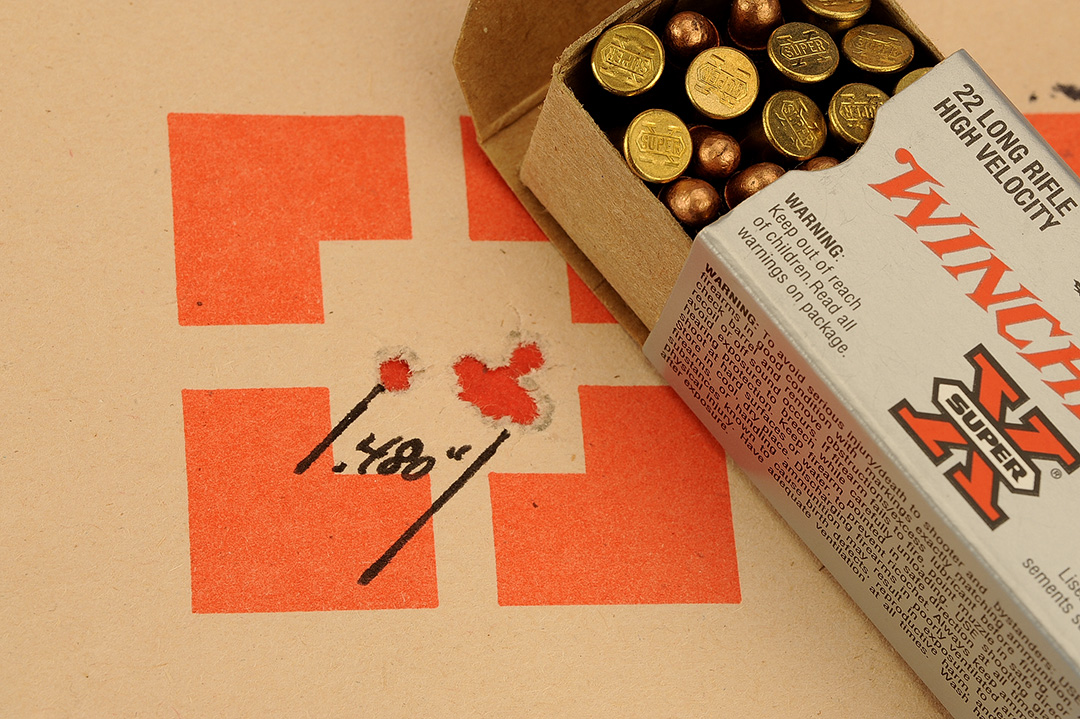
While any gun is nice to look at, it is downrange that matters. While the gun is accurate at 25 yards, Stan decided to stretch it out to 50 yards. This is the best single group measuring a curt .480 inch center to center with Winchester High Velocity ammunition.
Of course, handling a gun is nice, but shooting it is even better! Loading up with a variety of .22 Long Rifle ammunition, I spent a pleasant morning not only shooting targets for record, but also just having fun. Granted, the outside temperature here in New England was nothing to brag about in the mid-30s, but without the wind, the gun did its thing from the bench.
With Blazer ammunition, five-shot groups were pleasant to shoot at 50 yards, thanks to the mild recoil of the rimfire cartridge and the internal mechanism of the Ruger. For the five-shot groups, Federal’s Target brand hit .875 inch with the best going .780 inch. Next, the Blazer ran an average of .813 inch with the best group coming in at .578. Finally, Winchester’s High Velocity brand averaged out to .547 inch, with the best of the best placing all shots within a .480-inch group. The rest of the morning was spent walking around the various shooting points, picking out targets downrange and plinking away like this gun was made to be! The Ruger 10/22 has certainly earned its reputation for accuracy and reliability that still stands today.
Over the years, Ruger’s Model 10/22 has worn many faces. From a wide variety of stocks, actions in carbon and stainless steel and its ability to be customized to shooter requirements, this special .22-caliber rifle still ranks tall among its peers.












